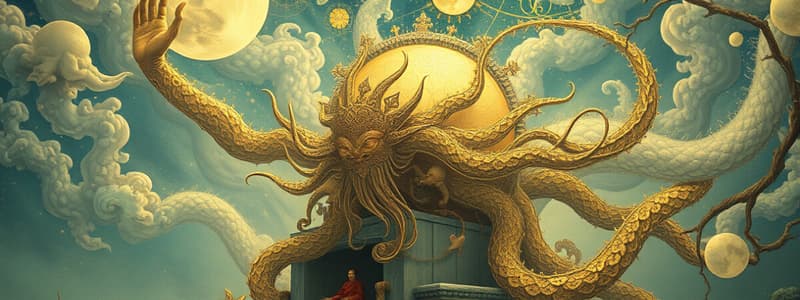Podcast
Questions and Answers
What primarily composes the Earth's crust?
What primarily composes the Earth's crust?
- Light elements such as silicon, oxygen, and aluminum (correct)
- Rocks and liquid materials
- Gas molecules like nitrogen and oxygen
- Dense metals like nickel and iron
What characterizes the outer core of the Earth?
What characterizes the outer core of the Earth?
- It is solid and consists of iron and nickel
- It is part of the mantle layer
- It causes Earth's magnetic field
- It is liquid and made up of iron and nickel (correct)
Which layer of the Earth exhibits 'plasticity' and is involved in convection currents?
Which layer of the Earth exhibits 'plasticity' and is involved in convection currents?
- Outer Core
- Upper Mantle
- Lithosphere
- Asthenosphere (correct)
What is the thickness range of the continental crust?
What is the thickness range of the continental crust?
What two gases make up 99% of the Earth's atmosphere?
What two gases make up 99% of the Earth's atmosphere?
The Moho boundary separates which two layers?
The Moho boundary separates which two layers?
Which of the following correctly describes oceanic crust compared to continental crust?
Which of the following correctly describes oceanic crust compared to continental crust?
The inner core of the Earth is characterized as being:
The inner core of the Earth is characterized as being:
How deep is the lower mantle where convection currents occur?
How deep is the lower mantle where convection currents occur?
Which element has the highest concentration in Earth's atmosphere?
Which element has the highest concentration in Earth's atmosphere?
Flashcards are hidden until you start studying
Study Notes
Earth and Its Unique Properties
- Earth is the only planet in the solar system that supports life due to its unique properties.
- The planet consists of four subsystems: atmosphere, hydrosphere, lithosphere, and biosphere, facilitating the flow of matter and energy.
Creation of Earth
- Earth's formation resulted from processes that shaped the Solar System, allowing life to emerge over geological time.
- Various creation theories, including cultural myths, explain the origins of Earth.
Korean Creation Myth
- Korean mythology contains a significant creation story: initially, there were no humans, and deities Yul-Ryeo and Mago emerged.
- Yul-Ryeo's resurrection led to the formation of Earth, its components (water, fire, soul), and subsequent creation of flora and fauna.
- Celestial beings, born from Mago, governed life from a celestial castle called 'Magoseong'.
Creation Narratives
- Creation myths are symbolic narratives handed down through generations via oral traditions like stories and poems.
Theories of Universe Formation
- Big Bang Theory: Outlines the universe's formation and subsequent processes leading to stars and galaxies.
- Descartes' Vortex Theory: Proposed by René Descartes; suggests the Solar System formed from whirlpool-like motions of pre-solar materials.
- Buffon’s Collision Theory: George Louis, Comte de Buffon theorized planets formed from debris after the sun collided with a giant comet.
Kant-Laplace Nebular Theory
- Proposed by Immanuel Kant and Pierre Simon Laplace; suggests planets formed from a collapsing nebula, spinning and flattening due to gravity.
Jeans-Jeffrey’s Tidal Theory
- Sir James Hopwood Jeans and Harold Jeffreys posited that planets were formed from material torn off the sun by a passing massive star’s gravitational pull.
Solar Nebular Theory
- Introduced by Emanuel Swedenborg; describes planets forming from a nebular crust surrounding the Sun that eventually broke apart.
Earth’s Formation and Layers
- Through accretion, different types of planets emerged, from terrestrial to Jovian, leading to the composition of Earth's layers:
- Crust: Composed mainly of light elements (silicon, oxygen, aluminum).
- Mantle: Consists of rocks; divided into asthenosphere (soft) and lithosphere (rigid).
- Core: Dense metals (nickel and iron); divided into outer (liquid, magnetic) and inner core (solid, magnetic).
Composition of Earth's Atmosphere
- Composed primarily of nitrogen (78%) and oxygen (21%).
- Trace gases include argon, carbon dioxide, and others, making up the remaining 1%.
Layers of Earth's Crust
- Oceanic Crust: Dark, more dense, composed of basalt, average thickness of 5-10 km.
- Continental Crust: Light, less dense, made of granite, averaging 40-70 km in thickness.
Biosphere Hierarchy
- The organization of life forms represents the hierarchy of life, sometimes visualized as a pyramid of life, indicating the complexity and interdependence of living organisms.
Studying That Suits You
Use AI to generate personalized quizzes and flashcards to suit your learning preferences.



